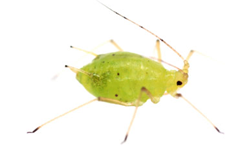
Lawn Pests
Looking for information on lawn pests in South Florida? You have found the right place on the web! Most homeowners in South Florida take pride in maintaining their gardens and landscapes. But healthy landscapes can bring certain South Florida bugs, and these pests feed on plants and grass. Unless protective pest control measures are taken, various outdoor invaders can do extensive damage to your yard and garden.
Chinch bugs are seriously damaging to St Augustine and other turf grass species. They suck the plant juices through their needle-like beak and can also cause other internal injuries to the grass, which can result in yellowish and brown patches in lawns. These affected areas are frequently noticed first along concrete or asphalt-paved edges, or in water-stressed areas where the grass is growing in full sun.
Aphids and whitefly feed on vegetable plantings, ornamentals and tender plant parts such as grass shoots, sucking out essential fluids. Aphids and scale excrete a sweet substance known as honeydew that attracts ants and forms a sticky coating on leaves. The honeydew can form a fungus called “sooty mold,” which can make leaves, especially on ornamentals, look black and dirty. Aphids can also transmit plant viruses to their food plants, which can cause the plant to die. These pests, as well as chinch bugs, are particularly prevalent throughout the spring months.
Armyworms, sod webworms and grubworms eat the grass blades and shoots that make up healthy lawns, causing major damage to various kinds of turf grass. They are common during the fall months.
During fall and winter, mites and scale are common. Scale insects live in the soil and suck the juices from the grass roots of turf grass; they can also be harmful to ornamental plants. Symptoms attributed to scale insects include yellowing of the grass, followed by browning; scale damage becomes most noticeable when the grass is under stress due to drought, nutritional deficiencies and other afflictions. Ordinarily not a pest in well-managed lawns, mites are known to attack grasses. They suck the sap and cause leaves to appear blotched and stippled, and severe infestations can also kill plants.
Some of these pests are especially damaging since they are literally born and raised on lawn turf grass in the surrounding soil. Sod webworms eat various grasses as larvae and continue doing so as adults. Others, like mole crickets, destroy lawns by tunneling through the soil near the lawn’s surface, which loosens the soil so that the grass is often uprooted and dies due to the drying out of the root system. They also feed on grass roots, causing thinning of the turf, eventually resulting in bare soil. Mole crickets are common when the temperatures are the warmest and rainfall and humidity is high. They can also be found in and around your home in dark, damp places.
Slugsandsnails often move about on lawns and may injure adjacent plants. They are night feeders and leave mucous trails on plants and sidewalks. Plaster bagworms, close relatives of the clothes moth, are often found in sheds and garages.


